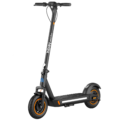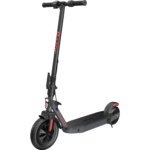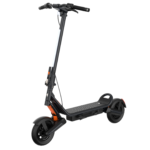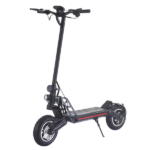- Home
- Scooters
- Electric Scooters
- Hiboy X300
Hiboy X300
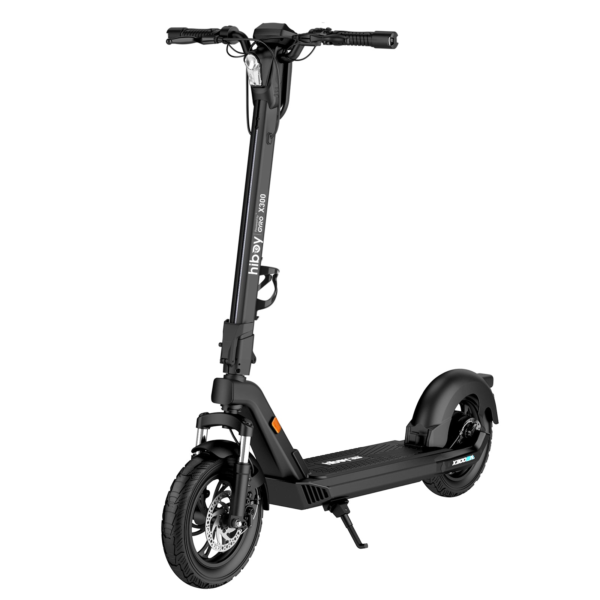


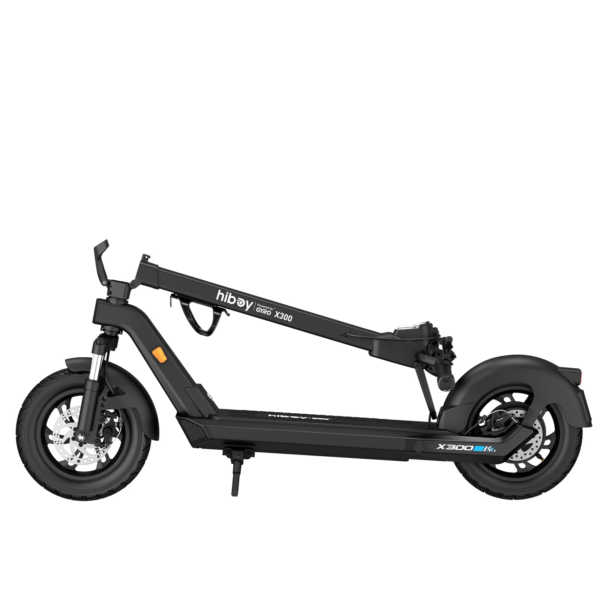
- Battery Range: 34 mi (55 km)
- Top Speed: 28 mph (45 km/h)
- Motor Power: 800 W nominal
- Weight Capacity: 265 lb (120 kg)
- Charging Time: ~6–7 h
- Scooter Weight: 60.0 lb (27.2 kg)
PROS
- Strong power for hills and headwinds
- 11×3.0″ off-road pneumatic tires
- Front & rear suspension for comfort
- Dual braking for confident control
- Longer-range battery for weekend loops
CONS
- Heavier to carry upstairs
- Pneumatic tires require pressure care
- Not ideal for tiny apartments
- Overkill for ultra-short commutes


Table of contents
- Introduction: Why the Hiboy X300 Stands Out
- Who the Hiboy X300 Is Best For
- Design Philosophy: Built for Real Roads
- Ride Feel: Composed, Grippy, and Quietly Quick
- Performance for Real Life: Speed, Modes, and Hill Behavior
- Battery, Range, and Charging Rhythm
- Braking and Control: Strong, Linear, and Confidence-Building
- Lighting and Visibility: See and Be Seen
- Portability and Storage: Realistic, Not Minimalist
- Comfort and Ergonomics: Fit It to Your Body
- Maintenance: Five-Minute Habits That Prevent Headaches
- Weather and Surface Conditions: Adjust Your Technique
- Security and Charging Habits
- Day-One Setup Checklist
- Everyday Scenarios: How the X300 Performs
- Battery Care for Long Life
- Tires, Flats, and Ride Quality
- Accessibility and Learning Curve
- Etiquette: Ride Well in Shared Spaces
- How the X300 Fits in the Hiboy Lineup
- Pros and Cons at a Glance
- Final Thoughts: A Scooter That Shrinks the City
Introduction: Why the Hiboy X300 Stands Out
The Hiboy X300 targets riders who want a stronger, more planted commuter that can handle imperfect streets without flinching. Instead of focusing strictly on ultra-light portability, it leans into stability, torque, and control. Consequently, it suits heavier riders, longer routes, and commutes with real hills. Moreover, it brings a confidence-boosting chassis and sensible ergonomics that make daily miles feel calm rather than chaotic. In short, the X300 reads like a “sport-commuter”—comfortable enough for the weekday grind yet sturdy enough for spirited weekend rides. If you’re cross-shopping inside the brand, you might also consider the lighter sibling, the Hiboy S2, as a portability-focused benchmark.
At the same time, it remains approachable. Because the controls are intuitive and the acceleration is progressive, the learning curve feels shorter than you’d expect from a more capable scooter. As a result, new owners can settle into a safe rhythm quickly while experienced riders still enjoy the headroom to stretch.
Who the Hiboy X300 Is Best For
Riders with mixed terrain and real hills. The X300’s punchier drive and composed geometry help on rolling grades. Therefore, you can hold practical speeds without feeling like you’re wringing the scooter’s neck.
Daily commuters who prioritize stability. Wider tires and a longer wheelbase (relative to compact scooters) calm down steering. Consequently, straight-line cruising and quick lane changes feel predictable.
Heavier riders or those carrying gear. A sturdier deck and chassis inspire confidence when you add a backpack or laptop bag. Additionally, the planted ride quality reduces wobble with extra weight.
Weekend explorers. If your Saturday loop includes bike paths, park connectors, and patchy pavement, the X300’s traction and braking leave more margin for surprises. Meanwhile, the cockpit layout stays simple so you can pay attention to the road, not the screen.
Anyone upgrading from an entry-level model. Coming from a small, twitchy scooter, you’ll immediately notice calmer steering and stronger braking. Thus, the jump in overall control is meaningful even before you consider speed or range.
Design Philosophy: Built for Real Roads
The X300’s design language is utilitarian rather than flashy. Accordingly, the priorities are composure, serviceability, and straightforward operation.
- Stout frame and tidy cabling. As a result, the scooter feels tight under load and resists creaks or bar flex.
- Roomy deck with durable grip. Consequently, you can vary foot placement on longer rides without losing traction.
- Logical cockpit. Throttle, brake levers, and display live where your hands expect them. Therefore, glances are short and your eyes stay up.
- Fold that favors rigidity. The latch mechanism targets solid riding feel first and quick carry second. Even so, it still collapses fast enough for trunk stowage.
- Tires chosen for city abuse. Wider, puncture-resistant rubber reduces pinch flats and soaks up chatter; however, proper pressure remains essential.
Overall, the package is less about showing off and more about surviving pothole season with grace.
Ride Feel: Composed, Grippy, and Quietly Quick
Although the X300 has more grunt than compact commuters, its personality is composed rather than jumpy. Because the throttle mapping is progressive, launches are smooth. Likewise, the steering tracks straight at speed, which reduces mid-ride fatigue.
- Cornering confidence. Wider contact patches and a stable stance let you arc through bends without constant micro-corrections. In practice, you spend less energy “settling” the scooter after bumps.
- Suspension support (where equipped). On rough segments, compliant hardware and tire volume work together. Consequently, brickwork, expansion joints, and patched asphalt feel less dramatic.
- Noise and vibration control. A well-damped chassis cuts buzzing at the bars. Therefore, your hands and wrists feel fresher after longer runs.
Altogether, the X300 feels like it shrinks the city. So, routes that used to demand caution become pleasantly routine.
Performance for Real Life: Speed, Modes, and Hill Behavior
Commuters need usable performance, not bragging rights. Accordingly, the X300 balances acceleration with control.
- Ride modes with intention. Eco-style settings conserve range and tame throttle response in crowded zones; then, higher modes unlock brisk pace on open straights.
- Hill strategy that works. On moderate grades, maintain a steady throttle rather than surging. Consequently, motor temps and battery draw stay happier, and your average speed remains consistent.
- Stop-and-go composure. Urban riding means traffic lights, crosswalks, and mid-block pauses. Therefore, predictable throttle pickup and firm braking make the bike-lane dance feel seamless.
Bottom line, the X300 hits that daily sweet spot where pace feels effortless rather than edgy.
Battery, Range, and Charging Rhythm
Range claims are always best-case. In reality, air temperature, rider weight, hills, tire pressure, and cruising speed all matter. Therefore, build a personal buffer and plan conservatively.
- Plan your loop. Map typical mileage, add 20–30% margin, and note how much charge remains when you return. Over time, you’ll create a “mental fuel gauge” that’s more accurate than bars alone.
- Charge with intent. Many riders plug in after work or overnight. Moreover, partial top-offs are fine for daily use, which can be gentler on cells than constant 0–100% cycling.
- Seasonal adjustments. Cold weather reduces available energy. Consequently, start fully charged, ride smoothly, and consider a midday top-off in winter.
Ultimately, habitual planning beats spec-sheet optimism.
Braking and Control: Strong, Linear, and Confidence-Building
Power is only fun if you can rein it in. Accordingly, the X300 emphasizes decisive, linear braking.
- Two-lever familiarity. Front and rear systems provide balanced control. Therefore, you can modulate force with one or two fingers while keeping your grip secure.
- Emergency stop practice. First, find an empty lot. Then, shift hips back, bend knees, and squeeze firmly yet progressively. As a result, the scooter stays planted and your stopping distances shrink.
- Electronic assist behavior. If regenerative or electronic braking is present, learn its ramp. Consequently, you can trail-brake into corners without unsettling the chassis.
In summary, braking inspires trust, which encourages safer speeds everywhere else.
Lighting and Visibility: See and Be Seen
Urban safety depends on conspicuity. Therefore, treat lighting as part of your daily kit, not an afterthought.
- Aim the headlight correctly. Point slightly downward to light the path without dazzling oncoming riders. After folding, re-check the angle.
- Boost rear presence. Integrated lights are good; however, a clip-on tail beacon makes you unmissable at dusk.
- Reflective details. Helmet stickers, ankle bands, and side reflectors add motion cues. Consequently, drivers identify you sooner.
Together, these small moves create big safety margins.
Portability and Storage: Realistic, Not Minimalist
The X300 prioritizes road manners over featherweight carries. Even so, it remains manageable if you plan ahead.
- Stairs and hallways. One flight is fine; however, repeated up-and-down journeys will feel like a workout.
- Office routine. Fold neatly, lean with a frame pad, and protect floors with a small mat on rainy days. As a result, coworkers stay happy and the scooter stays clean.
- Car trunk stowage. Hatchbacks and SUVs are easiest. Consequently, weekend trips and park rides remain spontaneous.
In effect, you trade a few pounds for a lot of stability.
Comfort and Ergonomics: Fit It to Your Body
Comfort comes from setup as much as from components. Therefore, spend five minutes dialing in your stance.
- Footwork. Angle your lead foot 20–30 degrees, keep knees soft, and swap leading feet on longer rides. Consequently, circulation improves and hotspots fade.
- Bar rotation and lever reach. Align levers with your forearm’s natural angle. As a result, wrists stay neutral and brake control improves.
- Gloves and shoes. Light gloves damp buzz without muting lever feel; flat-soled shoes grip the deck well. Meanwhile, padded socks reduce fatigue on bumpy routes.
Altogether, tiny tweaks pay big dividends.
Maintenance: Five-Minute Habits That Prevent Headaches
A sturdy scooter still appreciates attention. Accordingly, create a quick routine.
Weekly (or every ~50–80 km):
- Inspect tires for cuts and embedded debris; then, check pressure or tread wear.
- Wipe the frame to spot loose fasteners and cable rub. Additionally, verify latch play at the fold.
- Test lights and the bell/horn at night.
Monthly:
- Check brake pad wear and cable/line tension; thereafter, fine-tune lever throw.
- Confirm bar clamp, stem hardware, and axle nuts are snug—however, avoid over-tightening.
- Spin wheels to listen for gritty bearings; if noise appears, address it early.
Seasonally:
- Deep clean with gentle detergent, soft brushes, and a thorough dry-down. Then, lightly lube pivot points (never rotors or pads).
- Track your “miles per bar” on a familiar loop; if it drops suddenly, investigate tires and battery.
Overall, these habits keep the X300 feeling new longer.
Weather and Surface Conditions: Adjust Your Technique
Light rain. Wider rubber keeps contact more consistent; nevertheless, paint stripes, steel plates, and wet leaves remain slick. Therefore, brake earlier, ride upright, and avoid abrupt throttle inputs.
Cold. Chemistry slows in low temps; consequently, range shrinks. Meanwhile, proper tire pressure matters even more for grip.
Heat. Hot days stress batteries and tires. Accordingly, avoid leaving the scooter in a closed car or direct sun for hours. Additionally, check pressure before evening rides.
Rough patches and gravel. Let the front end roll with a light grip; in turn, the chassis stays composed and traction remains predictable.
Security and Charging Habits
- Lock like you mean it. A quality U-lock through frame to a fixed anchor is baseline. Moreover, pair it with a cable for wheels if hardware allows.
- Vary parking spots. Predictability invites theft; therefore, rotate locations when possible.
- Charge smart. Use the correct charger on a ventilated surface; meanwhile, a simple timer can prevent excessive full-charge float.
Taken together, these habits protect both scooter and battery health.
Day-One Setup Checklist
- Unbox carefully, and save packaging for future shipping needs.
- Torque-check bar clamp, stem latch, axle nuts, and brake hardware—then re-check after your first ride.
- Set units and modes, and explore the display while stationary.
- Dial lever reach so one or two fingers can brake comfortably.
- Inflate or verify tires to recommended specs; afterward, ride a short shakedown loop.
- Photograph the scooter and record the serial number for insurance.
- Plan a lock routine, and practice at home before your first café stop.
- Create reminders for weekly and monthly checks.
- Assemble a mini kit: multi-tool, wipes, small wrench, and a strap to secure the folded stem.
- Practice emergency stops in an empty lot; finally, note your real-world stopping distance.
Consequently, you start safer, smoother, and smarter.
Everyday Scenarios: How the X300 Performs
The cross-town commuter with hills. Set a mid ride mode, keep a steady throttle on grades, and let the scooter climb without surging. Therefore, you arrive calm with consistent charge use.
The errand loop with a backpack. Load weight on your back rather than the handlebar. As a result, steering stays precise and braking remains balanced.
The park-path cruise. Roll at an easy pace, ring early when passing, and enjoy the quiet. Meanwhile, use the outing to refine bar angle and lever reach.
The post-rain coffee run. Leave extra margin around paint and leaves, keep speeds moderate, and brake earlier. Consequently, the trip feels drama-free despite damp surfaces.
Battery Care for Long Life
Lithium-ion cells prefer moderation. Accordingly:
- Avoid deep drains when you can; instead, charge soon after low-battery rides.
- Don’t store at 100% for weeks; rather, park around 50–70% if the scooter will sit.
- Keep cool and dry; therefore, skip hot trunks and damp sheds.
- Partial top-offs are fine; in fact, many riders run 80–90% for daily use and save full charges for longer trips.
Ultimately, gentle habits preserve capacity across seasons.
Tires, Flats, and Ride Quality
The X300’s wider rubber is your first line of comfort and control. Nevertheless, maintenance matters.
- Pressure discipline. Under-inflation steals range and can invite pinch flats; conversely, over-inflation reduces grip on choppy pavement.
- Line choice. When possible, avoid sharp-edged potholes and debris fields. For example, detouring one meter can save a tire.
- Gloves help. Thin cycling gloves cut vibration while preserving lever feel. Additionally, they improve grip in wet weather.
- Inspect often. Catching cuts early extends tire life and avoids roadside fixes.
In any case, treat tires as safety equipment, not consumables you ignore.
Accessibility and Learning Curve
Although the X300 is more capable than entry-level scooters, it remains approachable. Fortunately, simple practice builds skill fast.
- Start in the lowest mode, practice smooth launches, and perform gentle slaloms.
- Then, explore moderate speeds on quiet streets.
- Meanwhile, rehearse emergency stops and weight shift until they feel automatic.
- Soon, bike lanes and mixed traffic feel natural.
Consequently, confidence grows without encouraging risky behavior.
Etiquette: Ride Well in Shared Spaces
- Be predictable; therefore, hold your line and signal early.
- Yield to pedestrians; moreover, slow to walking pace in crowded areas.
- Use your bell; for instance, give a friendly ring before passing.
- Park courteously; finally, fold and place out of the walkway.
As a result, everyone enjoys the lanes a bit more.
How the X300 Fits in the Hiboy Lineup
Within the brand’s range, the X300 lives between compact commuters and heavy performance machines. Compared with lightweight models, it offers more stability, traction, and braking bite. Conversely, it avoids the bulk and cost of extreme, high-wattage scooters. Nevertheless, it provides the daily pace and rough-road calm that many riders actually need. Therefore, if you want a capable, confidence-forward commuter without going overboard, the X300 makes excellent sense.
Pros and Cons at a Glance
Pros
- Composed chassis with stable, confidence-inspiring steering
- Strong, linear braking and predictable throttle mapping
- Wider tires for traction and comfort on imperfect streets
- Practical ride modes for both crowded zones and open straights
- Straightforward maintenance with easy, five-minute checks
Cons
- Heavier than ultra-portable commuters
- Firmer carry experience on stairs and transit
- Range and pace still respond to hills, temperature, and tire pressure
- Larger footprint demands more storage space at home or work
Final Thoughts: A Scooter That Shrinks the City
The Hiboy X300 combines stability, traction, and control into a package that feels effortless in real life. Because the chassis runs calm and the brakes inspire trust, you can focus on traffic, path choice, and scenery rather than on keeping the scooter in line. Moreover, the performance ceiling is high enough for challenging routes while the interface remains simple for daily use. Consequently, the X300 becomes a scooter you reach for again and again—weekday commutes, weekend loops, and everything in between. If you value planted handling, predictable power, and low-drama miles, then this model belongs near the top of your shortlist. In the end, it turns rough roads into routine and long crossings into short hops.
Specifications
General
| Model The Model specifies the exact version or name of the scooter. It helps identify its unique design, features, and specifications within the manufacturer’s product line. Knowing the model makes it easier to compare options, find compatible accessories, or look up support information. | X300 |
| Brand The Brand identifies the manufacturer or company that designs and produces the scooter. A trusted brand is a sign of quality, reliability, and good customer support. Well-known brands often have higher standards for safety, performance, and after-sales service, giving you more confidence in your purchase. | Hiboy |
| Release Date The Release Date indicates when the scooter model was officially launched on the market. This helps you know how current the design, technology, and features are. A newer release date often means updated components, improved performance, and the latest safety or smart features. | 17 November 2025 |
| Recommended Age Recommended Age indicates the minimum age range that the scooter is designed for, based on safety, size, and ease of use. Following the recommended age helps ensure that riders can handle the scooter’s speed, weight, and controls comfortably and safely. Always check local laws and use protective gear, especially for younger riders. | Recommended 16+ |
Performance & Power
| Motor Power (Wattage) What it means: The motor power, measured in watts (W), shows how strong the scooter’s electric motor is. Why it matters: Higher wattage usually means better acceleration, more torque, and improved performance on hills or rough terrain. For example, a 250W motor is good for flat city roads and light riders, while a 500W or 1000W motor provides more power for faster speeds or climbing steep inclines. | 800 W nominal (1200 W peak) |
| Top Speed The Top Speed indicates the maximum speed that the scooter can reach under optimal conditions. It’s usually measured on level ground with a fully charged battery and an average rider weight. A higher top speed allows you to travel longer distances faster, but always ensure you ride within legal speed limits and your personal comfort zone for safety. | 28 mph (45 km/h) |
| Battery Capacity Battery Capacity refers to the total amount of energy the scooter’s battery can store, usually measured in ampere-hours (Ah) or watt-hours (Wh). A higher battery capacity means you can ride longer distances on a single charge, reducing the need for frequent recharging. Keep in mind that actual range can vary depending on rider weight, terrain, speed, and weather conditions. | 48 V 15 Ah |
| Estimated Range per Charge The Estimated Range per Charge indicates the average distance the scooter can travel on a single full battery charge. This range is calculated under optimal conditions, such as flat terrain, moderate speed, and average rider weight. Real-world range may vary depending on riding style, terrain, weather, and load. A longer range means fewer recharges and greater freedom for longer trips. | Up to 34 mi (55 km) |
| Hill Climb Ability Hill Climb Ability describes the maximum incline or slope that the scooter can handle while maintaining stable performance. It’s typically expressed as a percentage or in degrees. A higher hill climb rating means the scooter can tackle steeper hills without losing too much speed or power. Actual climbing performance may vary based on rider weight, battery charge, and terrain conditions. | Up to 25° grades |
| Drive System The Drive System refers to how power from the motor is delivered to the wheels. Electric scooters typically use either a hub motor (directly integrated into the wheel) or a chain/belt drive system. A high-quality drive system ensures smooth acceleration, efficient power transfer, and low maintenance. The choice of drive system affects performance, noise level, and overall ride experience. | Rear hub motor (RWD) |
Charging & Electrical
| Charging Time Charging Time indicates how long it takes to fully recharge the scooter’s battery from empty to 100% using the standard charger provided. Faster charging means less downtime and more time on the road. Actual charging time may vary slightly depending on battery capacity, charger output, and environmental conditions. | Approx. 6–7 hours |
| Battery Type Battery Type refers to the specific technology used in the scooter’s battery, which affects performance, lifespan, weight, and charging time. Most modern electric scooters use high-quality lithium-ion (Li-ion) batteries because they offer a good balance of energy density, durability, and low maintenance. A reliable battery type ensures consistent power delivery and longer riding ranges. | Li-ion with Smart BMS |
| Removable Battery A Removable Battery means the battery pack can be easily detached from the scooter for convenient charging and replacement. This feature allows you to charge the battery separately, swap it with a spare for extended range, or securely store it indoors in extreme weather. Removable batteries add flexibility and make it easier to keep your scooter powered up wherever you are. | No external fast charge |
| Regenerative Braking Regenerative Braking is an energy-saving feature that converts some of the energy normally lost during braking back into battery power. When you slow down or brake, the motor works in reverse to generate electricity, which helps extend the scooter’s range and improves overall efficiency. This system also reduces wear on traditional brake components, leading to lower maintenance over time. | Regenerative electronic assist |
| Lighting Lighting refers to the built-in front and rear lights that enhance visibility and safety when riding in low-light conditions or at night. Good lighting helps you see the road ahead and ensures that other road users can see you. Many scooters include LED headlights, taillights, and sometimes brake lights or side reflectors for added safety and compliance with local traffic regulations. | High-output headlight + tail/brake |
Build & Dimensions
| Scooter Weight Scooter Weight refers to the total weight of the scooter when fully assembled, including the battery. This affects how easy it is to carry, lift, and store the scooter when not in use. A lighter scooter is more portable and convenient for commuting, especially if you need to carry it upstairs or onto public transport. Keep in mind that a sturdy frame and quality components may add to the weight but also contribute to better durability and ride stability. | 60.0 lb (27.2 kg) |
| Maximum Rider Weight Maximum Rider Weight indicates the highest rider weight that the scooter is designed to safely support while maintaining optimal performance and stability. Staying within this limit helps ensure reliable acceleration, braking, and climbing ability, and it protects the frame, suspension, and motor from excessive strain. Exceeding the recommended limit may reduce performance and increase wear on components. | 265 lb (120 kg) |
| Deck Size Deck Size refers to the dimensions of the scooter’s standing platform. A wider and longer deck provides more foot space, allowing you to stand comfortably and adjust your stance while riding. A well-sized deck improves balance and stability, especially on longer rides or at higher speeds. Compact decks, on the other hand, help keep the scooter lightweight and portable. | Wide deck; long wheelbase |
| Handlebar Height Handlebar Height refers to the distance from the deck to the handlebars, which affects your riding posture and comfort. An appropriate handlebar height helps you maintain good balance, reduces strain on your back and arms, and makes steering more comfortable. Some scooters have adjustable handlebars to fit riders of different heights, while others have a fixed height for a streamlined design. | Adult fixed bar height |
| Folding Mechanism The Folding Mechanism describes how easily and securely the scooter can be folded for carrying and storage. A well-designed folding system lets you quickly collapse the scooter into a compact size, making it convenient to transport on public transit, store under a desk, or fit into a car trunk. Look for sturdy latches and safety locks to ensure the scooter stays firmly in place when folded or unfolded. | Quick folding latch |
| Dimensions Folded Dimensions indicate the size of the scooter when it’s fully folded. This measurement shows how much space the scooter will take up when stored or carried, making it easier to check if it will fit in your car trunk, under a desk, or in a closet. Compact folded dimensions are ideal for commuters who need to bring their scooter on public transport or store it in tight spaces. | 48.0 × 24.0 × 22.0 in (folded) |
| Material Material refers to the primary construction materials used for the scooter’s frame and key components. High-quality materials like aircraft-grade aluminum, reinforced steel, or durable composites provide strength, stability, and a lighter overall weight. A sturdy material ensures the scooter can handle daily wear and tear while maintaining safety and performance. | Aluminum alloy |
Safety & Control
| Brake Type(s) Brake Type(s) describe the braking systems the scooter uses to help you slow down or stop safely. Common brake types include mechanical brakes (like drum or disc brakes), electronic brakes, and foot brakes. Many scooters combine multiple braking systems for added safety and shorter stopping distances. The type and quality of brakes affect your control, especially when riding at higher speeds or on slopes. | Front & rear mechanical discs + e-brake |
| Suspension Suspension refers to the system that absorbs shocks and vibrations while riding, providing a smoother and more comfortable ride over uneven or rough surfaces. Scooters may have front suspension, rear suspension, or dual suspension for better shock absorption and stability. Good suspension helps reduce rider fatigue and improves control, especially when riding on bumpy roads or off-road paths. | Front fork + rear spring |
| Tire Type Tire Type refers to the kind of tires the scooter uses, which directly affects ride comfort, traction, and maintenance. Common types include solid (airless) tires, pneumatic (air-filled) tires, or hybrid options. Pneumatic tires offer better shock absorption and a smoother ride on rough surfaces, while solid tires are puncture-proof and require less upkeep. The right tire type helps ensure safe handling and a comfortable ride in different conditions. | Off-road pneumatic |
| Tire Size Tire Size indicates the diameter and width of the scooter’s tires, which affect ride comfort, stability, and how well the scooter handles different terrains. Larger tires generally offer better shock absorption and a smoother ride over bumps and rough surfaces, while smaller tires keep the scooter lighter and more portable. Choosing the right tire size helps ensure a balance between agility and comfort. | 11-inch |
| Kickstand The Kickstand is a built-in stand that allows you to park your scooter upright when it’s not in use. A sturdy kickstand keeps the scooter stable and prevents it from tipping over, protecting it from scratches and damage. It also makes storing and accessing your scooter more convenient, whether you’re at home, work, or on the go. | Side kickstand |
| Water Resistance Rating Water Resistance Rating indicates how well the scooter is protected against water and moisture, usually shown as an IP (Ingress Protection) rating. This rating helps you understand whether the scooter can handle light rain, splashes, or wet roads without damage. While most scooters are not fully waterproof, a good water resistance rating adds peace of mind when riding in changing weather conditions. Always avoid deep puddles or submerging the scooter to protect its electrical components. | IPX4 body |
Features & Extras
| Display/Console The Display (or Console) shows important real-time information about your ride, helping you monitor your scooter’s status at a glance. Typical displays show speed, battery level, distance traveled, and riding mode. Some models also include additional features like Bluetooth connectivity, app integration, or backlighting for better visibility at night. A clear and easy-to-read display enhances safety and convenience on every trip. | LCD dashboard |
| Ride Modes Ride Modes refer to the different speed and power settings you can choose to match your riding style or road conditions. Common modes include eco for maximum range and energy efficiency, standard for everyday balance, and sport or turbo for higher speed and stronger acceleration. Switching between ride modes allows you to customize performance, conserve battery, and ride safely in various environments. | Eco, Drive, Sport + Cruise |
| Smart App Connectivity Smart App Connectivity lets you pair your scooter with a dedicated mobile app via Bluetooth. Using the app, you can monitor real-time ride stats like speed, battery level, and range, adjust settings such as ride modes or cruise control, lock the scooter for added security, and sometimes receive firmware updates. This feature adds convenience and allows you to personalize your riding experience right from your smartphone. | Bluetooth app connectivity |
| Anti-Theft System The Anti-Theft System helps protect your scooter from unauthorized use or theft. This feature can include built-in alarms, electronic motor locks, GPS tracking, or remote locking through a mobile app. A good anti-theft system provides peace of mind when parking your scooter in public spaces, adding an extra layer of security to safeguard your investment. | Electronic lock via app |
| Cruise Control Cruise Control allows you to maintain a steady speed without continuously holding the throttle. This feature makes longer rides more comfortable by reducing hand fatigue and providing a smoother, more relaxed riding experience — especially on flat, open roads or bike lanes. For safety, cruise control can usually be easily activated or deactivated while riding. | Yes (cruise control) |
| Accessories Included Accessories Included lists the additional items that come with the scooter to enhance your riding experience and convenience. Common accessories may include a charger, kickstand, bell, lights, phone holder, or carrying strap. These extras add value by making your scooter safer, easier to use, and ready to ride straight out of the box. | Bell, reflectors, charger |
Warranty & Compliance
| Warranty Period The Warranty Period indicates how long the manufacturer guarantees the scooter against defects in materials and workmanship under normal use. A good warranty provides peace of mind, showing the brand’s confidence in its product quality. Always check what parts are covered, such as the frame, battery, and motor, and follow the maintenance guidelines to keep your warranty valid. | Typically 12 months (regional) |
| Certifications Certifications confirm that the scooter meets specific safety, quality, and environmental standards set by recognized organizations or regulatory bodies. Common certifications may include CE, RoHS, UL, or other local compliance marks, depending on your region. These certifications ensure that the scooter is manufactured to high standards and is safe and legal to use in your country. | Local e-scooter compliance |
Price Comparison





